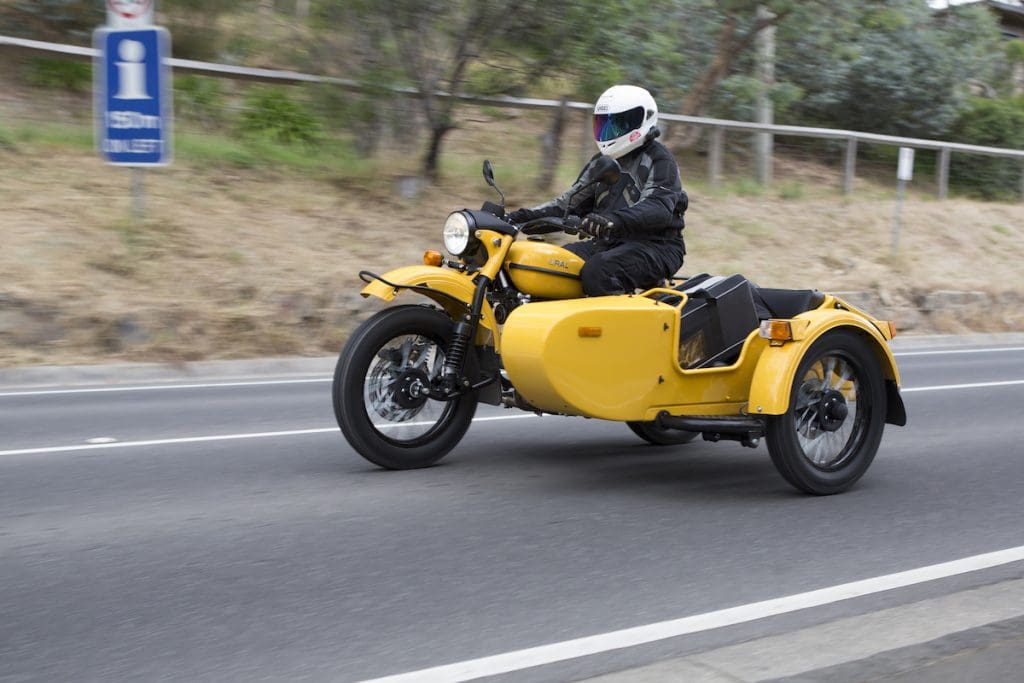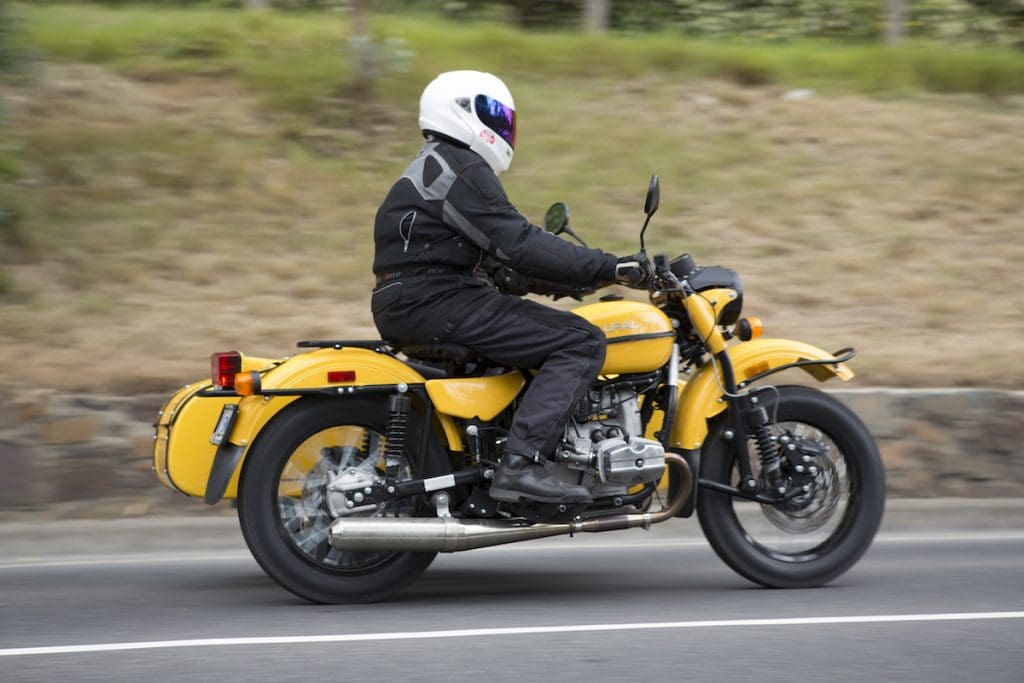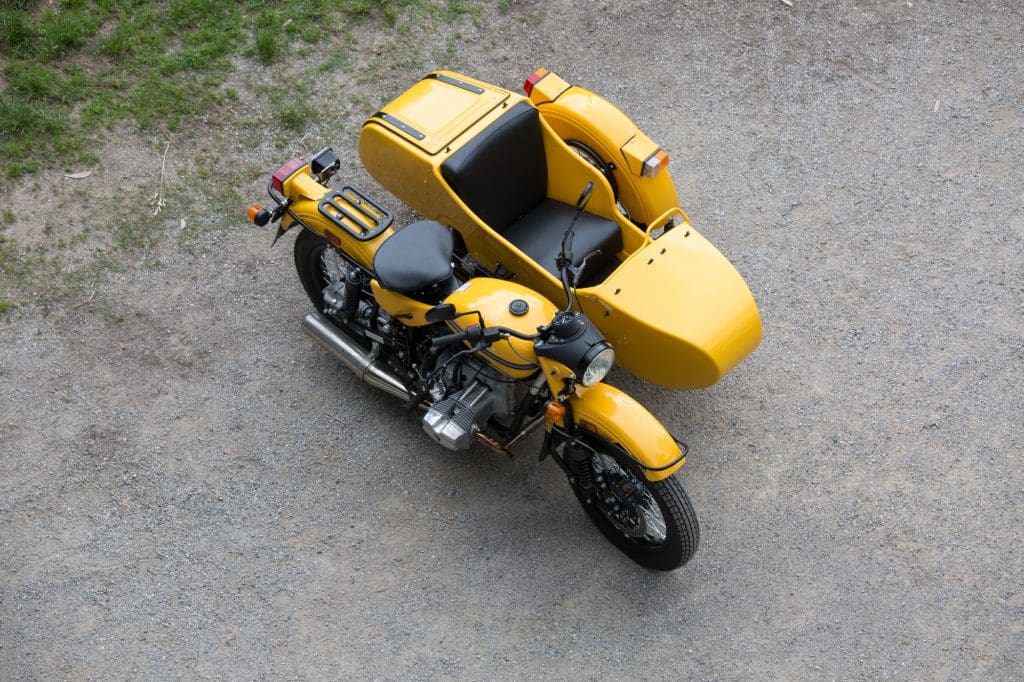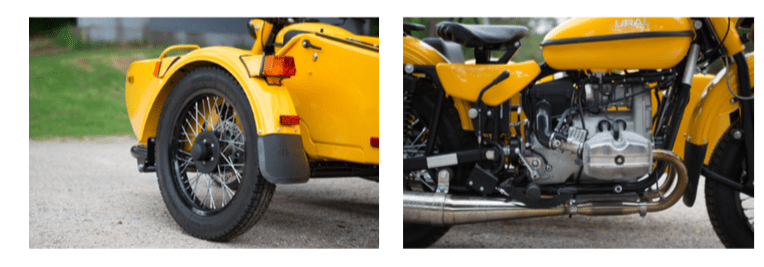When it comes to sidecar action, Ural continues to produce the only factory-made sidecars sold in Australia. And Ural Australia has recently released a new model: the cT.
Intended for the urban adventurer, the new machine is wider, lower and has lower gearing.

Like all current Ural models, the new bike is an air-cooled and injected 750cc flat twin. Included is a reverse gear and, to accommodate NSW rules, a parking brake that engages both the rear and the sidecar brakes. All brakes on all three wheels are Brembos, the Ural factory happily buying in various components that include shocks, alternator and injection system parts. The rotors on the front and sidecar wheels are floating but the rear is fixed.
The new model has 18-inch wheels, over the 19s fitted to existing Ural models, effectively lowering the gearing slightly and giving access to a wider selection of tyres. Despite this, the outfit will happily maintain 100km/ h with some in reserve, and the lower gearing makes stop-and-go traffic less of a chore.
Like existing Urals, the new bike is powder-coated rather than painted, but using a new colour unique to the cT called Bondi yellow.

Despite its Communist era origins and BMW copycat beginnings, the Ural is now a competent, smooth and extremely robust machine that could easily be an everyday-commuter rather than just a weekend toy.
In its current injected form, the engine is smooth, quiet and offers a broad spread of power, though not a great deal of it – at 30.75kW, this 750 isn’t going to win any races. Yet a new camshaft offers more midrange torque and certainly the roll-on power is substantial.
The gearbox however, is less cooperative. Probably because our test rig was a scant 59km old, gear changes were either a cacophony of grinding or a resolute clanging that made drivers of nearby cars change lanes in case cogs would soon be scattered across the road. Just like the early BMW upon which it is based, the Ural has a big flywheel and a dry engine-speed clutch that will not be rushed.
It also has a heel-and-toe shift lever, which is well and good – upshifts made by pushing down with the heel were smoother – except that the heel section was so stubby that it was almost impossible to reach, obscured by the kickstarter lever. Yes, a kickstarter in 2015 and on a 750. As if that weren’t oddball enough, it’s on the left side and its stroke is at right angles to the bike. Anyone who has ridden a pre-1970s BMW will recognise this oddity. Hardly surprising, since the Ural’s origins are unashamedly pinched from a pre-WW2 BMW, the R71.

Another foot-related oddity: the intake tubes interfere with your ankles, especially on the right side, and the wiring to the injector can catch on pants legs. Our resident pessimist predicts that sooner or later the connector is going to get unplugged, or worse, snapped.
As the Ural is fuel injected, there is no choke or fuel tap to worry about, you just turn the key (conveniently sited on the left side of the headlight), push the Japanese style starter button and the engine fires instantly. In fact, the starter spins faster than the engine idles and we were regularly caught out, thinking the engine hadn’t started when it had. For the record, the Ural is very eager to get going. Off-idle fuelling could be cleaner, but the nature of a sidecar in general and a Ural in particular, will probably make this a low priority for most owners.
As standard, the cT comes with a solo saddle mounted on a stout rubber block. It’s surprisingly comfortable, though taller pilots may find it a bit tight for space: lifting the flat bars up will give more room, but at the expense of steering leverage.
Ural offers a couple of options, including a conventional bench seat or a separate pillion pad; the bench will offer more space, though the tractor-seat-style saddle was plenty comfortable for sub-six-footers.
The options list is extensive and includes screens for both sidecar and bike, the mats and tonneau cover fitted to the test bike, a spare wheel, a power outlet, picnic basket, luggage racks, jerry cans and so on.
One option denied to Australian sidecarists is that of two-wheel drive. Because our laws stipulate that a sidecar can only be fitted to the left side of a motorcycle, the popular two-wheel drive feature isn’t available here. Even without it, the Ural’s traction is impressive, probably thanks in no small part to its weight – a not-inconsiderable 335kg – plus the special Heidenau sidecar tyres now fitted as standard.
For experienced sidecar drivers (rather than riders), the Ural is solidly made unit with few vices or surprises. It comes with a stout leading link front end and an adjustable hydraulic damper that hits the sweet spot between too much and too little trail, offering straight line stability good enough for single-handed operation and light enough steering to permit cornering at decent speeds without nervous or twitchy handling. Ural has been building sidecars since 1942, so the company has had enough time to get it right
All three wheels can be locked up on wet roads or on dirt, the chair can be flown (albeit with some effort) and the steering is predictable in both directions. As with most rigid sidecars, some ballast in the chair – in the form of either a teenage daughter or 40 litres of water – aids greatly in stability, especially in left-handers.
The all-metal sidecar body is attached to the bike with four hefty brackets that allow adjustment of toe-in and lean with threaded adjusters on clevis pins. A rod links the bike’s rear brake pedal to a separate master cylinder for the sidecar’s brake.

The sidecar itself is spacious and comfortable; although the simple seat doesn’t look it, it’s surprisingly supportive and there’s a useful footrest too – what a rally navigator would call a Jesus pedal. Besides the cavernous foot well, there’s also a useful boot too, claimed to hold a respectable 83 litres of cargo.
For those not used to sidecars, they can be terrifying to ride. They don’t lean like a motorcycle, they don’t steer the same going left and right, they are much wider on the left than you expect and when things start to go wrong, they do so with frightening haste.
For the uninitiated, steering a sidecar uses an action like steering a boat – the handlebars become a tiller and are physically moved from left to right. The throttle and brakes also play a part. For left-handers, it’s good to be able to accelerate into the turn, to drive the bike around the nose of the sidecar. Conversely, going into right handers, a stab of front brakes on turn-in will allow the sidecar’s momentum to initiate the turn. They are subtleties in an unsubtle world.

A sidecar can also be called a combination, an outfit or merely a rig. Properly licenced and registered they can legally carry up to four people and passengers are required to wear a motorcycle helmet.
In some countries, a special class of licence is required to operate a bike fitted with a sidecar. Much as we hate additional legislative interference, this is not without merit.
Ural has tapped into a small but enduring vein of demand for a tiny offshoot from mainstream motorcycling which defies all logic: a three-wheeled vehicle that behaves differently going left or right, that gets stuck in traffic and allows rider and passengers to get wet in the rain. Happily, there are still some eccentrics out there that appreciate a bit on the side.
TEST STEVE KEALY PHOTOGRAPHY BEN GALLI













